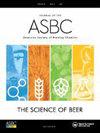Impacts of Adjunct Incorporation on Flavor Stability Metrics at Early Stages of Beer Production
IF 1.8
4区 农林科学
Q4 BIOTECHNOLOGY & APPLIED MICROBIOLOGY
Journal of the American Society of Brewing Chemists
Pub Date : 2023-01-02
DOI:10.1080/03610470.2021.1993054
引用次数: 5
Abstract
Abstract The fresh flavor of a beer brand is one of its most important quality parameters and should be retained as long as possible through shelf-life. Early stages of beer production can have significant impacts on beer flavor stability. The use of cereal adjuncts – either malted or unmalted – is now widespread practice in brewing. This laboratory mashing study investigated the impacts of incorporating common solid adjuncts (corn and rice) at increasing grist percentages (0-50%) on flavor stability indicators measured in wort. Sweet worts were analysed for metal ion levels (ICP-MS), thiol content (RP-HPLC), oxidative stability (EPR spectroscopy), staling aldehydes (HS-SPME-GC-MS), trihydroxy fatty acids (GC-FID), t-2-nonenal potential (GC-MS), color and thiobarbituric acid (TBI). Mashing conditions for each formulation were adjusted in order to achieve target FAN values. Unmalted rice or corn adjuncts significantly reduced the total metal ion content, color, TBI and staling aldehydes in sweet worts at 50% adjunct incorporation (p < 0.05), relative in each case to the respective all-malt control mash. Our findings showed that unmalted rice or corn adjunct incorporation generally improved flavor stability metrics in sweet worts when similar mashing conditions were applied, whilst increasing the length of the ‘protein stand’ in mashing to reach target FAN in general had a negative impact on flavor stability indicators – e.g., wort T150 values significantly decreased in each recipe at 25% and 35% adjunct relative to the 12.5% adjunct brew but increased again at 50% adjunct, presumably due to the prolonged proteolytic stand employed to achieve target FAN content.啤酒生产早期辅料掺入对风味稳定性指标的影响
摘要啤酒品牌的新鲜风味是其最重要的品质参数之一,应在保质期内尽可能长时间地保持。啤酒生产的早期阶段对啤酒风味的稳定性有很大的影响。谷物添加剂的使用——无论是麦芽的还是非麦芽的——现在在酿造中被广泛使用。本实验室研究了添加常见固体辅料(玉米和大米)以增加颗粒百分比(0-50%)对麦汁风味稳定性指标的影响。分析了麦汁的金属离子水平(ICP-MS)、硫醇含量(RP-HPLC)、氧化稳定性(EPR)、变质醛(HS-SPME-GC-MS)、三羟基脂肪酸(GC-FID)、t-2-烯醛电位(GC-MS)、颜色和硫代巴比托酸(TBI)。调整各配方的捣碎条件,以达到目标FAN值。与全麦芽对照醪相比,添加50%的未麦芽大米或玉米添加剂显著降低了麦汁中总金属离子含量、颜色、TBI和变质醛(p < 0.05)。我们的研究结果表明,在类似的捣碎条件下,未麦芽的大米或玉米添加剂的加入通常会改善麦汁的风味稳定性指标,而在捣碎过程中增加“蛋白质支架”的长度以达到目标FAN通常会对风味稳定性指标产生负面影响——例如,在每种配方中,25%和35%的添加剂相对于12.5%的添加剂酿造,麦芽汁T150值显著降低,但在50%的添加剂酿造时又会增加。可能是由于为了达到目标FAN含量而采用的蛋白水解立场延长了。
本文章由计算机程序翻译,如有差异,请以英文原文为准。
求助全文
约1分钟内获得全文
求助全文
来源期刊

Journal of the American Society of Brewing Chemists
工程技术-生物工程与应用微生物
CiteScore
4.00
自引率
20.00%
发文量
41
审稿时长
3 months
期刊介绍:
The Journal of the American Society of Brewing Chemists publishes scientific papers, review articles, and technical reports pertaining to the chemistry, microbiology, and technology of brewing and distilling, as well as the analytical techniques used in the malting, brewing, and distilling industries.
 求助内容:
求助内容: 应助结果提醒方式:
应助结果提醒方式:


